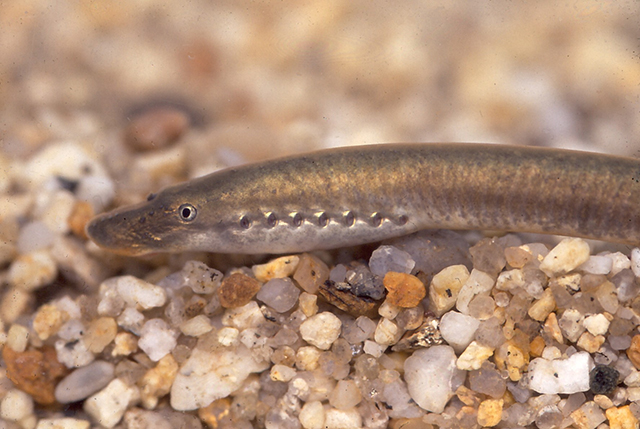| Petromyzontidae (Northern lampreys), subfamily: Lampetrinae |
| 20.5 cm TL (male/unsexed); max. reported age: 7 years |
|
demersal; freshwater, potamodromous |
| Europe: Great Britain north to Scottish highlands, rivers draining to North Sea north to Scotland and about Stavanger (Norway), Baltic Sea basin, Atlantic as far south as Adour drainage (France, Spain) and isolated populations in Sado, Tagus and Douro drainages (Portugal), Mediterranean basin in France and western Italy (south to about Cilento drainage). Locally in Ireland, upper Volga, upper Danube and some of their tributaries and Pescara drainage on Adriatic coast of Italy. |
|
Dorsal spines (total): 0-0; Dorsal soft rays (total): 0-0; Anal spines: 0-0; Anal soft rays: 0-0. Poorly developed fins, dorsal fins in contact in mature adults, blue-green back, yellow flanks, white ventral portion (Ref. 2163). Diagnostic features: Adults: 8.6-17.0 cm TL. Body proportions, as percentage of TL (based on 16 specimens measuring 10.6-13.3 cm TL): prebranchial length, 10.9-12.6; branchial length, 7.5-9.9; trunk length, 44.4-53.3; tail length, 25.4-31.4; eye length, 2.3-2.9; disc length, 5.2-7.0. Urogenital papilla length, as a percentage of branchial length, in ten spawning males measuring 11.1-14.0 cm TL, 21.4-52.6. Trunk myomeres, 60-65. Dentition: supraoral lamina, 2 unicuspid teeth; infraoral lamina, 7-9 teeth, usually all unicuspid, but occasionally one lateralmost bicuspid; 3 endolaterals on each side; endolateral formula, typically 2-3-2; 2 rows of anterials; first row of anterials, 9 unicuspid teeth; exolaterals absent; posterials absent; transverse lingual lamina, 9-13 unicuspid teeth, the median one enlarged; longitudinal lingual laminae each with about 9 unicuspid teeth. Velar tentacles, 4-6, with tubercles. Body coloration (preserved), dorsal and lateral aspects grayish, ventral surface whitish, dorsal fins and caudal fin yellowish. Some specimens display a prominent dark blotch at the apex of the second dorsal fin. The iris is yellow. Lateral line neuromasts unpigmented. Unpigmented caudal fin except for spawning individuals in which it is "weakly peppered". Caudal fin shape, spade-like (Ref. 89241). Sigmund Freud (Ref. 72450, 72451 ) described the development of the central nervous system of brook lamprey. |
| Adults are found in the lowland, piedmont and montane zone in clear, well oxygenated brooks (Ref. 59043). They live exclusively in freshwater; in middle and upper reaches of small streams and rivers, occasionally in lakes. Larvae lie buried in the substrate while adults live in the open water (Ref. 57699). Sexually mature adults have been observed burrowing in fine sand (Ref. 89241). Larvae of this species can serve as mid-term bio-indicators (Ref. 57699). They live in detritus-rich sands or clay sediments (Ref. 59043). Larval life is 5+ to 6+ years, with the smaller individuals of the latter year class delaying metamorphosis by one year. Metamorphosis occurs in September in the Czech Republic (Ref. 89241). Filter feeding larvae, non-feeding adults (= non-parasitic). Reproduction takes place upstream, from April to May (Ref. 30578). Duration of the life cycle is believed to last 6 years on average. Communal spawning in the same redd by L. fluviatilis and L. planeri has been reported in the River Tywi Basin, Wales (UK), in April, at a water temperature of 11 °C. Both species participated in constructing a redd about 23 cm in diameter and 5-8 cm deep, consisting of pebbles, gravel, and coarse sand. In the river Yeo, England (UK), peak spawning activity varies between 26 March and 24 April when water temperatures reach 10-11 °C. As the spawning season progresses, male:female ratios shift from 3.54:1 to 1.60:1. In the Czech Republic, both sexes participate in the redd construction in shady areas of streams that are 1-8 m in width and a few centimeters to 0.8 m in depth. Spawning occurs between 1 and 17 June at water currents 1-4 m/s and water temperatures 10-16 °C (Ref. 89241). Because of its small size and the mediocre quality of its meat, it is rarely fished. The larvae are utilized as bait (Ref. 30578). |
|
Least Concern (LC); Date assessed: 05 March 2010 Ref. (130435)
|
| harmless |
Source and more info: www.fishbase.org. For personal, classroom, and other internal use only. Not for publication.

